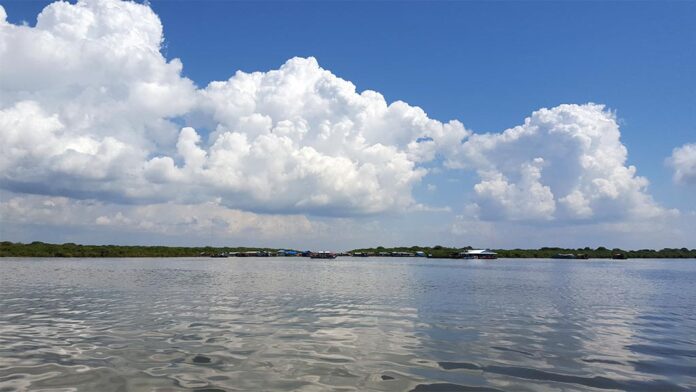Tonle Sap Lake is often referred to as the heart of Cambodia, it’s a giant, almost ocean-like, inland freshwater lake. The Tonle Sap River merges at Phnom Penh with the Mekong River and Tonle Bassac River. The flow of the river changes with the seasons and Cambodia relies on it for crops and fish in the different seasons. Siem Reap is the closest major town for visiting the Tonle Sap Lake.
Weather Cycles and Flow Reversal
Khmer New Year which occurs in April each year, signifies the end of the harvest season. It’s the time for Cambodian families to enjoy their harvest before the rainy season begins, around June. As the rain sets in, the water levels in the Mekong River rise and the flow from Tonle Sap is reversed.
Normally water from the Tonle Sap Lake flows along Tonle Sap River where it ultimately converges with the Mekong and Tonle Bassac River. When rainy season is in full swing, the higher water levels push the water back toward the lake. It’s quite a remarkable natural phenomenon. The lake essentially becomes a giant reservoir, swelling in size by up to 5 times and expanding through the surrounding wetlands. At this point, Tonle Sap transforms into the largest freshwater lake in Southeast Asia.
When the dry season arrives around November, the Tonle Sap Lake is full and everything is flourishing from. Water levels in the Mekong drop and the river flow goes back the other way again. Water Festival or Bom Om Touk (literally “boat festival”) symbolizes the end of the rainy season. Rice farmers have been working hard during the rainy season to cultivate one or two crops of rice and the water festival also indicated that the rice harvest is coming. There are ceremonies for pounding the rice, which is known as Ombok, and it is tradition to eat the pounded rice at this time of the year.
Tonle Sap Biosphere Reserve
The biodiversity of the Tonle Sap Lake is magnificent and unique. Radiating out from the lake itself are mangroves, tropical forests, marshlands and grasslands, which provide habitats for a huge range of animal species. The Prek Toal Bird Sanctuary is located at the western end of the Tonle Sap Lake and is well equipped to satisfy curious and expert birdwatching enthusiasts. As well as rare bird species, there are also reptiles, fish, mammals and insects that are integral to the biodiversity of this great lake. Some of the rare species that are now considered endangered include the Siamese Crocodile, Crab-eating Macaque, Spot-billed Pelican and Milky Stork.
The lake is also home to a unique species of water snake, the Tonle Sap Water Snake (Enhydris longicauda), also amongst the list of endangered species. Approximately 6.9 million snakes are caught each year from the lake, around 14 species in total. Many are the main food source for birds on the lake, their reduction in numbers will lead to disastrous effects on the biodiversity of this amazing lake. The snakes are primarily being harvested as food for both people (fish numbers are down, which has lead to many fishermen now harvesting snakes) and for crocodiles as the number of crocodile farms increases.
UNESCO denoted the area a biosphere reserve in 1997, helping to set up laws and regulations for the conservation of the area.
Living on Tonle Sap Lake
Whilst it’s unclear exactly how many people are living on and around the lake, it is documented that around 40% are living under the poverty line. Most communities are extremely poor and consist of predominantly Vietnamese or Cham. Life on the lake can be isolating and brutal. Access to sufficient education and healthcare are limited and exposure to the elements is demanding.
Stilted and Floating Villages
The communities living here need to be flexible and mobile. Often they will move their houses and main structures to different areas as the water rises and falls with the seasons. Many villages utilise a combination of permanent structures, stilted houses and buildings, and moveable houses that can be transported with the tide. These communities are more commonly known as stilted and floating villages.
Fishing and Farming
Fishing is a seasonal vocation for most families living on the Tonle Sap Lake and the grasslands are utilized for cattle grazing and family-scaled farming. The ebb and flow of the lake is critical to the harvest for sustaining food supplies for the people living in the area. Furthermore, much of the fish caught in the lake is transported to feed Cambodians throughout the country and a critical component of the economy, making up 16% of GDP.
Conclusion
Tonle Sap Lake is a significant resource for Cambodia; for its biodiversity, that supports so many lives in Cambodia. In recent years however, the levels of the Tonle Sap Lake have been alarmingly low; low rainfalls during wet season, increased strain on water resources from industry and periods of drought, attributed to climate change, have been evident to those who are familiar with this great lake. The ramifications for Cambodia could be disastrous.



